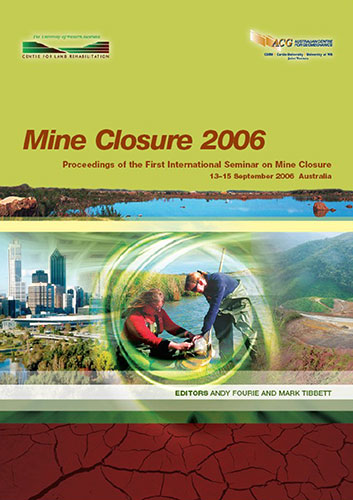Phosphorus Fertiliser Placement and Seedling Success in Australian Jarrah Forest

|
Authors: George, SJ; Tibbett, M; Braimbridge, MF; Davis, SG; Vlahos, S; Ryan, M Paper is not available for download Contact Us |
DOI https://doi.org/10.36487/ACG_repo/605_27
Cite As:
George, SJ, Tibbett, M, Braimbridge, MF, Davis, SG, Vlahos, S & Ryan, M 2006, 'Phosphorus Fertiliser Placement and Seedling Success in Australian Jarrah Forest', in AB Fourie & M Tibbett (eds), Mine Closure 2006: Proceedings of the First International Seminar on Mine Closure, Australian Centre for Geomechanics, Perth, pp. 341-349, https://doi.org/10.36487/ACG_repo/605_27
Abstract:
Natural re-colonisation following surface-mining is often slow and typically requires intervention if the re- establishment of a self-sustaining ecosystem integrated with the surrounding landscape is desired in human timescales. Current rehabilitation practices include an initial application of mineral fertilizer, especially phosphorus, to facilitate good seedling establishment and early ground cover. However, limited evidence suggests long-term effect of an over supply of P may result in disrupted nutrient cycling and the long-term exclusion of P sensitive species. South-west Australian jarrah forests are adapted to inherently low- phosphorus soils due to evolving from low P parent material and subsequent leaching of phosphate. As a result this type of ecosystem has a ‘tight cycle’ of internal redistribution of P in mature ecosystems. The agreed rehabilitation prescription involves ‘scarification’ (soil ripping to a depth of 30-40 cm during January to May) followed by broadcast seeding within 4 days. In August superphosphate (with Cu, Mo Zn) is applied by helicopter. A change from aerial application of fertiliser to a ground-based application at the time of scarification was proposed. To assess the impact of a P fertilizer placement (top-dressed or incorporated) and time of fertilisation (summer, autumn and winter), a large-scale field-trial was established in early 2004 in a post-mined area of Worsley Alumina’s Boddington Bauxite Mine (BBM), Western Australia. This paper evaluates the impact of these treatments on establishment and key growth characteristics of four northern jarrah forest species following the first growing season after field-trial establishment.
References:
Bell, D.T. and Heddle, E.M. (1989) Floristic, morphological and vegetational diversity. In: The Jarrah Forest – A
Complex Mediterranean Ecosystem, B. Dell, J.J. Havel and N. Malajcuk (eds), Kluwer, Dordecht.
Bolland, M.D.A. and Gilkes, R.J. (1998) The relative effectiveness of superphosphate and rock phosphate for soils
where vertical and lateral leaching of phosphate occurs. Nutrient Cycling in Agroecosystems. 51, pp. 139-153.
Colwell, J.D. (1963) The estimation of the phosphorus fertilizer requirements of wheat in southern New South Wales by
soil analysis. Australian Journal of Experimental Agriculture and Animal Husbandry. 3, pp. 190-197.
Dell, B. and Havel, J.J. (1989) The Jarrah Forest, an introduction. In: The Jarrah Forest – A Complex Mediterranean
Ecosystem, B. Dell, J.J. Havel and N. Malajcuk (eds), Kluwer, Dordecht.
Phosphorus Fertiliser Placement and Seedling Success in Australian Jarrah Forest S.J. George, et al.
348 Mine Closure 2006, Perth, Australia
Drew, M.C. (1975) Comparison of the effects of a localized supply of phosphate, nitrate, ammonium and potassium on
the growth of the seminal root system, and the shoot in Barley. New Phytologist 75, pp. 479-490.
Glossop, B.L. (1981) Assessment of the floral composition achieved by two topsoil handling techniques used for
rehabilitation of bauxite mined areas. Alcoa of Australia Ltd. Environmental Research Bulletin 11, Booragoon,
Western Australia.
Handreck, K.A. (1997) Phosphorus requrements of Australian native plants. Australian Journal of Soil Research. 35,
pp. 241-289.
Humphrys, H. (1987) An assessment of fertiliser requirements of seeded understorey species of a jarrah forest on a
rehabilitated, bauxite mined pit. Applied Mini Project. Curtin University of Technology, Western Australia.
Koch, J.M. and Davies, S. (1993) The effect of a tall dense Acacia understorey on small shrub and herb species native
to the jarrah forest. Alcoa of Australia Ltd. Environmental Research Bulletin 21, Booragoon, Western Australia.
Lockley, I.R. and Koch, J.M. (1996) Response of two eucalypt species to fertilizer application on rehabilitated bauxite
mines in Western Australia. Pinjarra, W.A., Alcoa of Australia Ltd. Environmental Research Bulletin 27,
Booragoon, Western Australia.
Marshner, H. (1986) Mineral Nutrition of Higher Plants. Academic Press, New York.
Matysiak, A. (1988) The influence of fertiliser type, rate and time upon mean height and number of Eucalyptus
marginata. Applied Biology Mini Project. Curtin University of Technology. Western Australia.
Maywald, D., McArthur, E.D., Jorgensen, G.L., Stevens, R. and Walker, S.C. (1998) Experimental evidence for sex-
based palatability variation in flowering saltbush. Journal of Rangeland Management. 51, pp. 650-654.
Mengel, K. and Kirby, E.A. (1998) Principles of Plant Nutrition. 5th Ed. Kluwer Academic Publishers, Dordecht.
Moore, G. (1998) Distinctive morphological features and their agricultural significance. In: Soil Guide. A Handbook for
Understanding and Managing Agriculutral Soils. (Ed. G. Moore). Agriculture Western Australia, Bulletin No.
4343.
Robinson, D. (1996) Resource Capture by Localized Root Proliferation: Why Do Plants Bother? Annals of Botany 77,
pp. 179-185.
Rohl, L. (1988) Fertiliser requirements for the establishment of Marri and Blackbutt by seed in rehabilitated bauxite
mines. Applied Biology Mini Project. Curtin University of Technology. Western Australia.
Tyree, M.T., Velez, V. and Dalling, J.W. (1998) Growth dynamics of root and shoot hydraulic conductance in seedlings
of five neotropical tree species: scaling to show possible adaptation to differing light regimes Oecologia 114,
pp. 293-298.
Van Vuuren, M.M.I., Robinson, D. and Griffiths, B.S. (1996) Nutrient inflow and root proliferation during the
exploitation of a temporally and spatially discrete source of nitrogen in soil. Plant and Soil 178, pp. 185-192.
Ecosystem Reconstruction and Pedogenesis
Mine Closure 2006, Perth, Australia 349
© Copyright 2025, Australian Centre for Geomechanics (ACG), The University of Western Australia. All rights reserved.
View copyright/legal information
Please direct any queries or error reports to repository-acg@uwa.edu.au
View copyright/legal information
Please direct any queries or error reports to repository-acg@uwa.edu.au